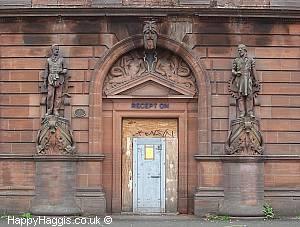Glasgow had been an important tobacco and cotton port from the early 18th century, being on the west coast of Scotland and facing North America. The River Clyde was quite shallow, and not deep enough for the larger ocean-going ships to reach the city, so cargo was transferred onto smaller ships at Port Glasgow or Greenock.
By the mid-19th century dredging of the Clyde began, and was finished in the 1880's, allowing the largest cargo ships access to Glasgow city centre.
 The wider, deeper River Clyde also attracted shipbuilding, and the industry was soon flourishing. The Clyde soon gained the reputation as being the British Empire's best shipbuilding location, and famous world-wide. The yards created merchant ships and warships as well as the luxury liners Queen Elizabeth 2 and Queen Mary. At its peak in the 1920s the Clyde shipbuilding industry employed over 100,000 people.
The wider, deeper River Clyde also attracted shipbuilding, and the industry was soon flourishing. The Clyde soon gained the reputation as being the British Empire's best shipbuilding location, and famous world-wide. The yards created merchant ships and warships as well as the luxury liners Queen Elizabeth 2 and Queen Mary. At its peak in the 1920s the Clyde shipbuilding industry employed over 100,000 people.
Clydebank sustained extensive damage from Nazi bombing raids during World war 2. After the war, there was a severe reduction in warship orders, but there was a continued boom in merchant shipbuilding.
During the 1950's shipbuilding in the Clyde began to decline, due to competition from overseas, and by the mid-1960's shipbuilding on the Clyde was becoming increasingly uneconomic and was facing collapse. The Government eventually nationalised most of the Clyde's shipyards, but despite this, only a couple survive today.
ADDITIONAL INFORMATION
Clydebuilt - part of the Scottish maritime Museum, Clydebuilt is a new attraction on the River Clyde bringing to life the story of Glasgow's development from the tobacco lords in the 1700's right up to the 21st century.
Glasgow City Council archives - includes shipbuilding records, plans, photographs, technical data, company minutes and cost books from a number of Clyde shipbuilders. Records of personnel information are less likely to have survived and so the shipbuilding archives are not always a good source of information for family history research.
Clydesite.co.uk - find details of ships built on the clyde. A database of over 20,000 records spanning 200 years. Also details of shipping lines.
Fairfield Shipbuilding & Engineering Co Ltd - history and archives at
The University of Glasgow website or at Wikipedia's Fairfield page.
K13 Fairfield Shipbuilding War Memorial located at Elder Park, Govan. 32 deaths occurred while the K13 submarine was undergoing trials on 29th January 1917.

John Brown & Co. Clydebank. Visit Wikipedia's John Brown page for historical information.
SS Daphne disaster occured 3rd July 1883 at Linthouse, Govan. While being launched the ship capsized, killing 124 person on board. History page including most names. 
Glasgow's shipyards have long been a stronghold of Protestantism. When Harland and Wolff of Belfast took over a shipyard at Govan in 1912 it brought a Protestant workforce to man it. This reinforced nearby Rangers FC as a protestant supporters team. It has been said this started the sectarian rivalry with Celtic at the east side of Glasgow.

HappyHaggis.co.uk ©